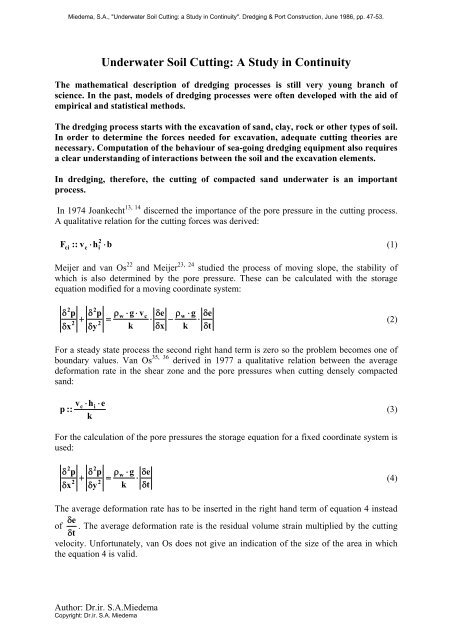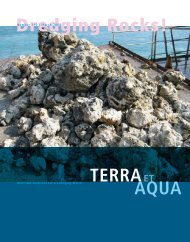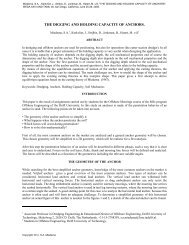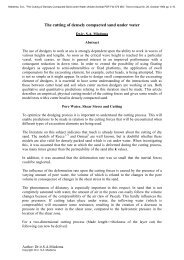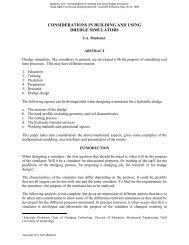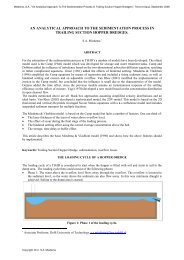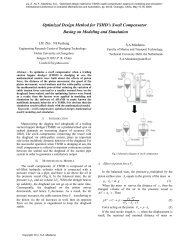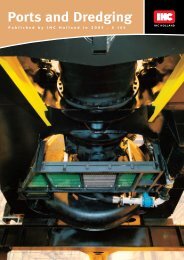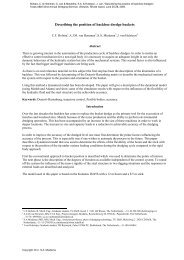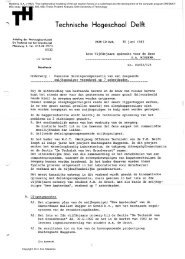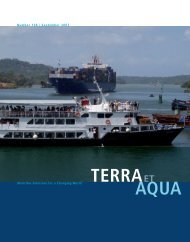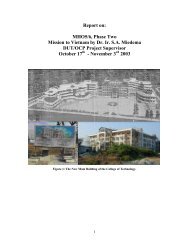Underwater Soil Cutting - Dredging Engineering Research Laboratory
Underwater Soil Cutting - Dredging Engineering Research Laboratory
Underwater Soil Cutting - Dredging Engineering Research Laboratory
You also want an ePaper? Increase the reach of your titles
YUMPU automatically turns print PDFs into web optimized ePapers that Google loves.
Miedema, S.A., "<strong>Underwater</strong> <strong>Soil</strong> <strong>Cutting</strong>: a Study in Continuity". <strong>Dredging</strong> & Port Construction, June 1986, pp. 47-53.<strong>Underwater</strong> <strong>Soil</strong> <strong>Cutting</strong>: A Study in ContinuityThe mathematical description of dredging processes is still very young branch ofscience. In the past, models of dredging processes were often developed with the aid ofempirical and statistical methods.The dredging process starts with the excavation of sand, clay, rock or other types of soil.In order to determine the forces needed for excavation, adequate cutting theories arenecessary. Computation of the behaviour of sea-going dredging equipment also requiresa clear understanding of interactions between the soil and the excavation elements.In dredging, therefore, the cutting of compacted sand underwater is an importantprocess.In 1974 Joankecht 13, 14 discerned the importance of the pore pressure in the cutting process.A qualitative relation for the cutting forces was derived:Fci:: vc2i⋅ h ⋅ b(1)Meijer and van Os 22 and Meijer 23, 24 studied the process of moving slope, the stability ofwhich is also determined by the pore pressure. These can be calculated with the storageequation modified for a moving coordinate system:δ2δxp2+δ2δyp2ρ=w⋅ g ⋅ vkc⋅δeδxρw⋅ g− ⋅kδeδt(2)For a steady state process the second right hand term is zero so the problem becomes one ofboundary values. Van Os 35, 36 derived in 1977 a qualitative relation between the averagedeformation rate in the shear zone and the pore pressures when cutting densely compactedsand:vp ::c⋅ hki⋅ e(3)For the calculation of the pore pressures the storage equation for a fixed coordinate system isused:δ2δxp2+δ2δyp2ρw⋅ g= ⋅kδeδt(4)The average deformation rate has to be inserted in the right hand term of equation 4 insteadδ eof . The average deformation rate is the residual volume strain multiplied by the cuttingδtvelocity. Unfortunately, van Os does not give an indication of the size of the area in whichthe equation 4 is valid.Author: Dr.ir. S.A.MiedemaCopyright: Dr.ir. S.A. Miedema
Miedema, S.A., "<strong>Underwater</strong> <strong>Soil</strong> <strong>Cutting</strong>: a Study in Continuity". <strong>Dredging</strong> & Port Construction, June 1986, pp. 47-53.Brakel 3 tried to calculate the pore pressures in 1982. For the residual volume strain a methodwas used based on rounded grains. Van Leussen and Nieuwenhuis 21 explained the influenceof the soil mechanics aspects in the cutting process in 1984.For the residual state of the deformed sand the critical (wet) density was found. The area ofthe shear zone is given while outside the shear zone the porosity is assumed to be constant.The undisturbed sand has a porosity of n i while the disturbed sand has a porosity of n cr .This implies that the right hand term of equation 4 is zero outside the shear zone in the modelof van Leussen and Nieuwenhuis.In 1982 Miedema 27, 31 combined the qualitative relations of Joanknecht 13, 14 and van Os 35, 36 ,which led to the following equation:Fciρ::w⋅ g ⋅ vc⋅ hkm2i⋅ b ⋅ e(5)In this model the average deformation rate is not inserted into the storage equation(Miedema 31 ). The deformation rate is modelled as a boundary condition in the shear zone,35, 36while the shear zone is modelled as a straight line instead of as an area as with van Osand van Leussen and Nieuwenhuis 21 .Steeghs 42 presented in 1985 a cutting force model based upon a dilatancy angel theory. Themodel is not based on continuous shearing as in Miedema 31 but on periodic shearing, so thatthe dynamic aspects of the cutting process are taken into consideration.In 1985 Miedema 32, 33 presented a theoretical cutting force model based on the assumptionsof 1982 27 and 1984 31 . In this model only the influence of the pore pressures on the cuttingforces was taken into account. This model was verified by model and prototype laboratorytests in the Technology of <strong>Soil</strong> Movement laboratory of the Delft University of Technology.32, 33This article is a combination of the two Miedema articles inConstruction, extended to include:<strong>Dredging</strong> + Port(1) inertial forces, according to Wismer and Luth 47(2) gravitational forces, adhesion and cohesion, according to Coulomb 45(3) under pressure behind the blade according to measurements carried out in theTechnology of <strong>Soil</strong> Movement laboratory(4) flow resistance as an added mass in the equation for the inertial forcesA large amount of interest was shown in the previous two Miedema articles 32, 33 and thisarticle should serve to increase reader understanding still further.Under pressure determination in the sand layerThe cutting process can be modelled as a plane strain process where a straight blade cuts alayer of sand (Figure 1). The layer of sand is deformed in the shear zone. During thisdeformation the volume of the sand changes as a result of the shear stresses in the shear zone(=deformation zone, =dilatation zone). This phenomenon is known as dilatation.Author: Dr.ir. S.A.MiedemaCopyright: Dr.ir. S.A. Miedema
Miedema, S.A., "<strong>Underwater</strong> <strong>Soil</strong> <strong>Cutting</strong>: a Study in Continuity". <strong>Dredging</strong> & Port Construction, June 1986, pp. 47-53.Figure 1: Diagram of the cutting processIn compacted sand the pore volume is increased as a result of the shear stresses in thedeformation zone. This increase is thought to be concentrated in the deformation zone whilethe latter is modelled as a straight line. Water will flow through the sand to the dilatation zoneto fill the increase in the pore volume.As a result of this flow the pore pressures in the sand decrease. This under pressure in thesand causes an increase in the grain stresses so that the forces needed for cutting are mainlydetermined by the dilatational properties of the sand.At low cutting velocities the cutting forces are also determined by the gravitational forces, thecohesion of the sand and the adhesion between the sand and the blade. At high cuttingvelocities the cutting forces are affected to a considerable extent by the inertial forces.With a steady state process the flow of water can be described in a moving coordinate systemwhich moves with the blade. The problem is limited to one of mixed boundary values. Thepotential theory can be used to describe the flow of water through the pores.For the calculation of the pore pressures it is necessary to have a proper formulation of theboundary condition in the shear zone.Miedema 31, 32 derived in 1984 a formula for the boundary condition in the shear zone.Outside the deformation zone the storage equation is valid:δ2δxp2+δ2δyp2= 0(6)The boundary condition in the deformation zone is in fact a specific flow rate (Figure 2)which can be determined from the following hypothesis.Author: Dr.ir. S.A.MiedemaCopyright: Dr.ir. S.A. Miedema
Miedema, S.A., "<strong>Underwater</strong> <strong>Soil</strong> <strong>Cutting</strong>: a Study in Continuity". <strong>Dredging</strong> & Port Construction, June 1986, pp. 47-53.For a sand element in the deformation zone the following increase in volume per unit of bladelength is valid:δ V = e⋅δA= e⋅δx⋅δhi = e⋅δx⋅ δl⋅ sin( β)(7)In which:en max − ni= (8)1 − nmaxThe flow rate to the sand element is:δ V δ xδ Q = = e ⋅ ⋅ δ l ⋅ sin( β ) = e ⋅ v c ⋅ δ l ⋅ sin( β )(9)δ t δ tWith the aid of Darcy’s law the following differential equation can be derived for the specificflow rate:qδ Qk i δ p k max δ p= = q 1 + q 2 = ⋅ + ⋅ = e ⋅ v c ⋅ sin( β ) (10)δ lρ ⋅ g δ n ρ ⋅ g δ nw1w2δpThe partial derivative is the derivative of the pore pressure perpendicular to a boundaryδn(in this case to the deformation zone). Figure 2 shows the partial derivatives of the boundariesof the pore pressure calculations. The boundaries where the pressure is hydrostatic (zero inthe calculation) are also shown.When distances are normalized by the thickness of the layer cut equation 10 can be writtenas:kkimaxδ pδ pρ⋅ g ⋅ v⋅ e ⋅ h⋅ sin( β )w c i⋅ + =with n’=δ n '1δ n '2k maxnh i(11)This equation can be made dimensionless by:δ pδ'pδ n '=(12)δ n ρ ⋅ g ⋅ v ⋅ e ⋅ h / kwcimaxAuthor: Dr.ir. S.A.MiedemaCopyright: Dr.ir. S.A. Miedema
Miedema, S.A., "<strong>Underwater</strong> <strong>Soil</strong> <strong>Cutting</strong>: a Study in Continuity". <strong>Dredging</strong> & Port Construction, June 1986, pp. 47-53.Figure 2: Boundary conditionThe prime of the partial derivative means that the derivative is dimensionless. The followingdimensionless equation is now valid as the boundary condition is the deformation zone:kkimax''δ p δ p⋅ + = sin( β )(13)δ n δ n12With the aid of the storage equation and the boundary conditions, the distribution of the porepressures in the sand around the blade can be determined. The finite element method(Segal 40 ) was used to calculate the dimensionless pore pressures.Figure 3 shows a possible mesh while figure 4 gives the distribution of the pore pressuresaround the blade (equipotential lines). The real pore pressures can be calculated byintegrating the derivative of the pore pressures over a streamline according to the nextsequence of equations:pcalculated'δ p= ∫ ⋅ ⋅ ds ' over a streamline s’s'(14)δ sBecause the pore pressure calculations are dimensionless the following transformation has tobe performed:prealδ pρ w ⋅ g ⋅ v c ⋅ e ⋅ h i δ p= ∫ ⋅ ⋅ ds = ⋅⋅ .ds 's s s'∫(15)δkδ smax'Author: Dr.ir. S.A.MiedemaCopyright: Dr.ir. S.A. Miedema
Miedema, S.A., "<strong>Underwater</strong> <strong>Soil</strong> <strong>Cutting</strong>: a Study in Continuity". <strong>Dredging</strong> & Port Construction, June 1986, pp. 47-53.With: s’= hsThis gives for the real pore pressures:prealρ⋅ g ⋅ v⋅ e ⋅ hw c i= ⋅ p calculated(16)k maxThis is illustrated in Figure 5.In the Technology of <strong>Soil</strong> Movement laboratory 80 cutting tests were carried out with bladeson which pore pressure transducers were mounted (Figure 1). The cutting experiments wereundertaken with blade angels of 30 deg., 45 deg. and 60 deg. at cutting velocities of 0.05 –2.0 m/sec, with cut layer thickness 25 – 180 mm and with sharp and worn edges.Figure 7 shows the dimensionless under pressure distribution on a blade with a blade angel of30 deg., a cut layer thickness of 50 mm and various cutting velocities. The under pressuremeasured shows a good correlation with those obtained from calculations. Figure 8 shows aregistration of the under pressures and the cutting forces during one of the tests. Thevariations of the under pressures are 20 – 50 per cent of average under pressures.Figure 3: Mesh for finite element calculationsAuthor: Dr.ir. S.A.MiedemaCopyright: Dr.ir. S.A. Miedema
Miedema, S.A., "<strong>Underwater</strong> <strong>Soil</strong> <strong>Cutting</strong>: a Study in Continuity". <strong>Dredging</strong> & Port Construction, June 1986, pp. 47-53.Figure 4: Result of finite element calculationsFigure 5: StreamlinesAuthor: Dr.ir. S.A.MiedemaCopyright: Dr.ir. S.A. Miedema
Miedema, S.A., "<strong>Underwater</strong> <strong>Soil</strong> <strong>Cutting</strong>: a Study in Continuity". <strong>Dredging</strong> & Port Construction, June 1986, pp. 47-53.Figure 8: Time registration of a testThe balance of forcesFor the calculation of the forces of the Coulomb method, in a generalized form, was used(Verruyt 45 ). This method is suitable when a straight shear plane is used. Figure 9 shows theforces which were brought to bear on the slice of sand in front of the blade. These forces are:- the force resulting from the under pressure in the shear zone :W 1- the force normal to the shear zone resulting from the grain stresses :N 1- the force parallel to the shear zone resulting from the shear stresses :S 1- the inertial force parallel to the shear zone :T- the cohesive force parallel to the shear zone :C- the force resulting from the under pressure on the blade :W 2- the force normal to the blade resulting from the grain stresses :N 2- the force parallel to the blade resulting from soil/interface :S 2Author: Dr.ir. S.A.MiedemaCopyright: Dr.ir. S.A. Miedema
Miedema, S.A., "<strong>Underwater</strong> <strong>Soil</strong> <strong>Cutting</strong>: a Study in Continuity". <strong>Dredging</strong> & Port Construction, June 1986, pp. 47-53.- the adhesive force parallel to the blade :A- the gravitational force :GFigure 10 shows the forces which are brought to bear upon the blade. These forces are:- the force resulting from the under pressure behind the blade :W 3- the above-mentioned forces: N 2 , S 2 , W 2 and AThe forces W 1 and W 2 follow from the under pressure calculations described above throughintegration of the under pressures over the shear zone and the blade. The force W 3 followsfrom measurement. The forces S and N are related according to:2 2= N ⋅ tan( )so K = (S N )(17)S 1 1 φ1 1 +2 2= N ⋅ tan( )so K = (S N )(18)S 2 2 δ2 2 +The unknown forces K 1 and K 2 remain. These forces can be derived from the horizontal andvertical balance of forces on the slice of sand in front of the blade. From this follows:12W⋅ sin( α + β + φ ) + W ⋅ sin(sin( α + β + δ + φ )21K 2 =φ )G ⋅ sin( β + φ ) + T ⋅ cos( φ ) + C ⋅ cos( φ ) −+sin( α + β + δ + φ )A⋅ cos(α+β+φ )(19)For the forces which are brought to bear by the sand on the blade:Fh223= − W ⋅ sin( α ) + K ⋅ sin( α + δ ) + A ⋅ cos( α ) + W ⋅ sin( α )(20)F v223= − W ⋅ cos( α ) + K ⋅ cos( α + δ ) − A ⋅ sin( α ) + W ⋅ cos( α ) (21)If no cavitation occurs W 1 and W 2 can be given as:W1P1mean⋅ v c ⋅ e ⋅ h i ⋅ b ⋅ ρ w ⋅ g= (22)(a ⋅ k + a ⋅ k ) ⋅ sin( β )1i22maxand:W2P2 mean ⋅ v c ⋅ e ⋅ h i ⋅ h b ⋅ b ⋅ ρ w ⋅ g= (23)(a ⋅ k + a ⋅ k ) ⋅ sin( α )1i2maxW 3 is about 30 – 60 per cent of W 2 . A limiting factor here is the situation in which cavitationoccurs throughout the entire sand mass around the blade. For the forces:W= ρ ⋅ g ⋅ ( z + 10 ) ⋅ h ⋅ b / sin( )(24)1 wi βAuthor: Dr.ir. S.A.MiedemaCopyright: Dr.ir. S.A. Miedema
Miedema, S.A., "<strong>Underwater</strong> <strong>Soil</strong> <strong>Cutting</strong>: a Study in Continuity". <strong>Dredging</strong> & Port Construction, June 1986, pp. 47-53.and:W= ρ ⋅ g ⋅ ( z + 10 ) ⋅ h ⋅ b / sin( )(25)2 wb αare then valid. The effect of cavitation on the under pressure behind the blade is stillunknown. The effect of the inertial forces has been investigated by Wismer and Luth 47 in1972. The following equation is derived:T' 2 sin( α )= ρ g ⋅ v c ⋅⋅ h i ⋅ b(26)sin( α + β )The cohesion and adhesion can be determined from soil mechanics tests. For the cohesiveand adhesive forces the following equations are valid:C = c ⋅ h i ⋅ b / sin( β )(27)A = a ⋅ h b ⋅ b / sin( α )(28)The gravitational force follows from:G⋅⎡⎢⎣=( ρ − ρ )⋅ g ⋅ hsin( α + β )⋅ b ⋅sin( β )( h + h ⋅ sin( α )) ( h ⋅ cos( α + β )) ⎤⎥⎦bsiwsin( α )i+i2 ⋅ sin(β )(29)This is in accordance with the area of the sand layer in Figure 9. The flow resistance which isnot explicit in this model can be seen as an added mass in equation 26:'gg( 1 + a )ρ = ρ ⋅(30)3Author: Dr.ir. S.A.MiedemaCopyright: Dr.ir. S.A. Miedema
Miedema, S.A., "<strong>Underwater</strong> <strong>Soil</strong> <strong>Cutting</strong>: a Study in Continuity". <strong>Dredging</strong> & Port Construction, June 1986, pp. 47-53.Figure 9: Balance of forces on layer cutFigure 10: Balance of forces on the bladeThe value of α, v c , h i , h b , b, ρ w , ρ s , ρ g and g are known or follow the geometry of the cuttingprocess. The value of δ, φ, n max , n i , k max and k i follow from investigation into the soil (vanLeussen and Nieuwenhuis 21 ). The value of the shear angel β is known. There are two basichypotheses concerning the determination of the shear angel. The Coulomb method for thecalculation of the cutting forces involves choosing a shear angel at which the total cuttingforces is at minimum (Lambe & Whitman 19 ). Hettiaratchi and Reece 8 use a logarithmic spiralfor the shear plane where the centre of the spiral is determined by the minimum total cuttingforce. The first method can be used for static cases of earth retaining structures.When cutting soil there is a continuous process of deformation and failure of the sand in frontof the blade. A criterion for the determination of the shear angel has to be chosen based onthe dynamic aspects of the cutting process. The shear angel is chosen at the level at which thechange in the energy, absorbed in the sand due to volume changes and transformed into heat,Author: Dr.ir. S.A.MiedemaCopyright: Dr.ir. S.A. Miedema
Miedema, S.A., "<strong>Underwater</strong> <strong>Soil</strong> <strong>Cutting</strong>: a Study in Continuity". <strong>Dredging</strong> & Port Construction, June 1986, pp. 47-53.is minimized. This is also postulated by Rowe 39 for the determination of slip lines. Thisenergy is equal to the product of the horizontal cutting force and the cutting velocity when theinertial forces are not taken into account.Because the vertical cutting force is small compared with the horizontal cutting force the twomethods will give approximately the same result. Steegh 42 opted for the second hypothesis.With the aid of the second hypothesis the shear angel can be determined as a function of α, δ,h bφ and . When the shear angel is known the forces Fh and F v can be calculated for differenthik iratios .kmaxFigure 11: Horizontal force as a function of the permeabilityAuthor: Dr.ir. S.A.MiedemaCopyright: Dr.ir. S.A. Miedema
Miedema, S.A., "<strong>Underwater</strong> <strong>Soil</strong> <strong>Cutting</strong>: a Study in Continuity". <strong>Dredging</strong> & Port Construction, June 1986, pp. 47-53.Figure 11 shows the horizontal cutting force as a function ofkthat the inverse of the horizontal cutting force is linear withkequation:kkimaximax. This figure also showsaccording to the following1Fhki= a + b ⋅(31)k maxThus:a b= 1 a + andba b= 2 a +(32)bThe cutting force model is verified by the cutting tests which were carried out. There is agood correlation between the measured and the calculated forces, as is shown is Figure 12.The forces is this are scaled to a cut layer thickness of 100mm and the blade width of 1m.The shaded parts indicate the distribution of the measured force while the effect of cavitationhas not been taken into account in this figure. The shear angels calculated also agree closelywith the shear angels observed in the video recordings, especially when the effects ofgravitational and inertial forces are taken into consideration.Figure 12: Measured versus calculated forceConclusionThe cutting force model presented here correlates closely with the measured under pressure,cutting forces and shear angels. However, the tests were carried out in one type of sand, so averification of the model in other types of sand is necessary.The limit situation where cavitation is reached did not occur in the tests. There is animprovement in the correlation between measured and calculated forces compared withAuthor: Dr.ir. S.A.MiedemaCopyright: Dr.ir. S.A. Miedema
Miedema, S.A., "<strong>Underwater</strong> <strong>Soil</strong> <strong>Cutting</strong>: a Study in Continuity". <strong>Dredging</strong> & Port Construction, June 1986, pp. 47-53.Miedema 32 . This improvement is caused by the gravitational and inertial forces which weretaken into account in this case.Bibliography(1) Biot, M A, “General Theory of Three Dimensional Consolidation”. Journal ofApplied Physic, Vol 12, pp 155 – 164, 1941(2) Bishop, A W, “The Strength of <strong>Soil</strong>s as <strong>Engineering</strong> Material”. Geotechnique, Vol16, No 2, pp 91 – 128, 1966(3) Brakel, J D, “Mathematisch Model Voor De Krachten Op Een Roterende SnijkopVan Een In Zeegang Werkende Snijkopzuiger”. Sc0/80/96 TH Delft, 1981(4) Boer, T J M de, “De Cutter”. Scriptie Sc0/77/81, TH Delft, 1977(5) Butterfield, R & Andrawes, K Z, “On The Angel Of Friction Between Sand AndPlane Surfaces”. Journal of Terramechanics Vol 8, No 4, pp 15 – 23, 1972(6) Hatamura, Y and Chijiiwa, K, “Analyses Of The Mechanism Of <strong>Soil</strong> <strong>Cutting</strong>”1 st report, Bulletin of the JSME, Vol 18, No 120, June 19751 st report, Bulletin of the JSME, Vol 19, No 131, May 19761 st report, Bulletin of the JSME, Vol 19, No 139, November 19761 st report, Bulletin of the JSME, Vol 20, No 139, January 19771 st report, Bulletin of the JSME, Vol 20, No 141, March 1977(7) Hansen, B, “Line Ruptures Regarded As Narrow Rupture Zones. Basic EquationsBased On Kinematic Consideration”. Proc Conf Earth Pressure Problems,Brussels, 1, pp 39 – 48, 1958(8) Hettiarachi, D R P & Witney, B D & Reece, A R, “The Calculation of PassivePressure Two Dimensional <strong>Soil</strong> Failure”. Journal Agric Engng Res 11 (2), pp 89 –107, 1966(9) Hettiarachi, D R P & Reece, A R, “Symmetrical Three-Dimensional <strong>Soil</strong> Failure”.J Terramech 1967, 4 (3), pp 45 – 67(10) Hettiarachi, D R P, “The Mechanics Of <strong>Soil</strong> Cultivation”. AES, paper No3/245/C/28, 1967(11) Hettiarachi, D R P & Reece, A R, “The Calculation Of Passive <strong>Soil</strong> Resistance”.Geotechnique 24, No 3, pp 289 – 310, 1974(12) Hettiarachi, D R P & Reece, A R, “Boundary Wedges In Two DimensionalPassive <strong>Soil</strong> Failure”. Geotechnique 25, No 2, pp 197 – 220, 1975(13) Joanknecht, L W F, “Mechanisch Graafonderzoek Onder Water”. TH Delft, Feb1973(14) Joanknecht, L W F, “<strong>Cutting</strong> Forces In Submerged <strong>Soil</strong>s”. TH Delft, 1974(15) Joanknecht, L W F, “Result of Tests on Two Cutterheads Operating in Sand”.First Int Symp <strong>Dredging</strong> Technology, Canterbury, England, 1975(16) Joanknecht, L W F, “A Review of Dredge Cutterhead Modelling andPerformance”. Proc WODCON VII, San Francisco, 1976(17) Josselin de Jong, G de, “Rowe’s Stress-Dilatancy Relation Based on Friction”.Geotechnique 26, No 3, pp 527 – 534, 1976(18) Koning, J de & Miedema, S A & Zwartbol, A, “<strong>Soil</strong>/Cutterhead Interaction UnderWave Conditions”. Proc WODCON X, Singapore, 1983(19) Lambe, T W & Whitman, RV, “<strong>Soil</strong> Mechanics, SI Version”. John Wiley & Sons,New York, 1979(20) Lanting, D, “Cutterproeven Met Cilindrische Snijkoppen In Aangetrild Zand”.Laboratoriumverslag LaO/81/97, TH Delft, 1977Author: Dr.ir. S.A.MiedemaCopyright: Dr.ir. S.A. Miedema
Miedema, S.A., "<strong>Underwater</strong> <strong>Soil</strong> <strong>Cutting</strong>: a Study in Continuity". <strong>Dredging</strong> & Port Construction, June 1986, pp. 47-53.(21) Lessuen, W van & Nieuwenhuis, J D, “<strong>Soil</strong> Mechanics Aspects of <strong>Dredging</strong>”.Geotechnique 34, No 3, pp 359 – 381(22) Meijer, K L & Os, A G van, “Pore Pressures Near Moving <strong>Underwater</strong> Slope”.Geotech, Engng Div ASCE 102, No GT4, pp 361 – 372(23) Meijer, K L, “Berekening Van Spanningen En Deformaties In VerzadigdeGrond”. Rapport R 914, deel 1, Waterloopkundig Laboratorium, 1981(24) Meijer, K L, “Computation of Stress and Strain in Saturated <strong>Soil</strong>”. Proef SchriftTH Delft, 1985(25) Miedema, S A, “De Grondreactiekrachten op een Kroonsnijkop die via eenLadder is Opgehangen in een Deiningscompensator”. LaO/81/97, TH Delft, 1981(26) Miedema, S A, “Computerprogramma ter Bepaling van de Reactiekrachten op deSnijkop, als Gevolg van de Bewegingen van de Snijkop”. StagerapportWaterloopkundig Laboratorium, Delft, 1981(27) Miedema, S A, “De Modellering van de Grondreacties op een Snijkop en hetOperationeel Maken van het Computerprogramma”. DREDMO. CO/82/125, THDelft, 1982(28) Miedema, S A, “De Interactie Tussen Snijkop en Grond in Zeegang”. ProcBaggerdag 19/11/1982, TH Delft, 1982(29) Miedema, S A, “Computersimulatie Bagger-Schepen”. De Ingenieur, Dec 1983(Kivi/Misset)(30) Miedema, S A, “Mathematische Modelvorming t.a.v. een Snijkopzuiger inZeegang”. TH Delft, 1984 (Kivi September 1984)(31) Miedema, S A, “The <strong>Cutting</strong> of Densely Compacted Sand Under Water”. Terra etAqua No 28, October 1984, pp 4 – 10(32) Miedema, S A, “Mathematical Modelling of the <strong>Cutting</strong> of Densely CompactedSand Under Water”. <strong>Dredging</strong> & Port Construction, July 1985, pp 22 – 26(33) Miedema, S A, “Derivation of the Differential Equation for Sand Pore Pressures”.<strong>Dredging</strong> & Port Construction, September 1985, pp 35(34) Nieuwenhuis, J D, “Failure of Sands in Plane Strain Tests”, LGM – Mededelingendeel XXI, No 2 1980, pp 171 – 177(35) Os, A G van, “Behaviour of <strong>Soil</strong> when Excavated Under Water”. InternationalCourse Modern <strong>Dredging</strong>. June 1977, The Hague(36) Os, A G van, “Snelle Deformatie van Korrelvormig Materiaal Onder Water”. Pt-p31 (1976) No 12, pp 735 – 741. Pt-p 32 (1977) No 8, pp 461 – 467(37) Osman, M S, “The Mechanics of <strong>Soil</strong> <strong>Cutting</strong> Blades”. JAER 9 (4) pp 313 – 328,1964(38) Reece, A R, “The Fundamental Equation of Earth Moving Machinery”. ProcSymp Earth Moving Machinery, Enst of Mech Eng, London, 1965(39) Rowe, P W, “The Stress Dilatancy Relation for Static Equilibrium of an Assemblyof Particles in Contact”. Proc Roy Soc A269, pp 500 – 527, 1962(40) Segal, G, “Sepra Analysis, Programmers Guide, Standard Problems and UserManual”. Ingenieurs Bureau Sepra, Leischendam, 1984(41) Sohne, W, “Some Basic Considerations of <strong>Soil</strong> Mechanics as Applied toAgricultural <strong>Engineering</strong>”. Grundlagen der Landtechnik (7), 11 – 27, 1956(42) Steeghs, H, “Snijden van Zand Onder Water (I & II)”. Ports & <strong>Dredging</strong> No 121June 1985, Ports & <strong>Dredging</strong> No 123 November 1985(43) Terzaghi, K and Peck, R B, “<strong>Soil</strong> Mechanics in <strong>Engineering</strong> Practice”. John Wiley& Sons, Inc, 1967Author: Dr.ir. S.A.MiedemaCopyright: Dr.ir. S.A. Miedema
Miedema, S.A., "<strong>Underwater</strong> <strong>Soil</strong> <strong>Cutting</strong>: a Study in Continuity". <strong>Dredging</strong> & Port Construction, June 1986, pp. 47-53.(44) Vermeer, P A, “Materiaalmodellen in de Grondmechanica”. TH Delft, 1983(collegedictaat)(45) Verruyt, A, “Grondmechanica”. Delftse uitgevers maatschappij, Nederland, 1983(46) Wismer, R D & Luth, H J, “Performance of Plane <strong>Soil</strong> <strong>Cutting</strong> Blades in Sand”.Trans ASEA No 69 – 115, 1969(47) Wismer, R D & Luth, H J, “Rate Effects in <strong>Soil</strong> <strong>Cutting</strong>”. Journal ofTerramechanics, Vol 8, No 3, pp 11 – 21, 1972Author: Dr.ir. S.A.MiedemaCopyright: Dr.ir. S.A. Miedema
Bibliography Dr.ir. S.A. Miedema 1980-20101. Koert, P. & Miedema, S.A., "Report on the field excursion to the USA April 1981"(PDF in Dutch 27.2 MB). Delft University of Technology, 1981, 48 pages.2. Miedema, S.A., "The flow of dredged slurry in and out hoppers and the settlementprocess in hoppers" (PDF in Dutch 37 MB). ScO/81/105, Delft University ofTechnology, 1981, 147 pages.3. Miedema, S.A., "The soil reaction forces on a crown cutterhead on a swellcompensated ladder" (PDF in Dutch 19 MB). LaO/81/97, Delft University ofTechnology, 1981, 36 pages.4. Miedema, S.A., "Computer program for the determination of the reaction forces on acutterhead, resulting from the motions of the cutterhead" (PDF in Dutch 11 MB).Delft Hydraulics, 1981, 82 pages.5. Miedema, S.A. "The mathematical modeling of the soil reaction forces on acutterhead and the development of the computer program DREDMO" (PDF in Dutch25 MB). CO/82/125, Delft University of Technology, 1982, with appendices 600pages.6. Miedema, S.A.,"The Interaction between Cutterhead and <strong>Soil</strong> at Sea" (In Dutch).Proc. <strong>Dredging</strong> Day November 19th, Delft University of Technology 1982.7. Miedema, S.A., "A comparison of an underwater centrifugal pump and an ejectorpump" (PDF in Dutch 3.2 MB). Delft University of Technology, 1982, 18 pages.8. Miedema, S.A., "Computer simulation of <strong>Dredging</strong> Vessels" (In Dutch). DeIngenieur, Dec. 1983. (Kivi/Misset).9. Koning, J. de, Miedema, S.A., & Zwartbol, A., "<strong>Soil</strong>/Cutterhead Interaction underWave Conditions (Adobe Acrobat PDF-File 1 MB)". Proc. WODCON X, Singapore1983.10. Miedema, S.A. "Basic design of a swell compensated cutter suction dredge with axialand radial compensation on the cutterhead" (PDF in Dutch 20 MB). CO/82/134, DelftUniversity of Technology, 1983, 64 pages.11. Miedema, S.A., "Design of a seagoing cutter suction dredge with a swell compensatedladder" (PDF in Dutch 27 MB). IO/83/107, Delft University of Technology, 1983, 51pages.12. Miedema, S.A., "Mathematical Modeling of a Seagoing Cutter Suction Dredge" (InDutch). Published: The Hague, 18-9-1984, KIVI Lectures, Section Under WaterTechnology.13. Miedema, S.A., "The <strong>Cutting</strong> of Densely Compacted Sand under Water (AdobeAcrobat PDF-File 575 kB)". Terra et Aqua No. 28, October 1984 pp. 4-10.14. Miedema, S.A., "Longitudinal and Transverse Swell Compensation of a CutterSuction Dredge" (In Dutch). Proc. <strong>Dredging</strong> Day November 9th 1984, DelftUniversity of Technology 1984.15. Miedema, S.A., "Compensation of Velocity Variations". Patent application no.8403418, Hydromeer B.V. Oosterhout, 1984.16. Miedema, S.A., "Mathematical Modeling of the <strong>Cutting</strong> of Densely Compacted SandUnder Water". <strong>Dredging</strong> & Port Construction, July 1985, pp. 22-26.17. Miedema, S.A., "Derivation of the Differential Equation for Sand Pore Pressures".<strong>Dredging</strong> & Port Construction, September 1985, pp. 35.18. Miedema, S.A., "The Application of a <strong>Cutting</strong> Theory on a <strong>Dredging</strong> Wheel (AdobeAcrobat 4.0 PDF-File 745 kB)". Proc. WODCON XI, Brighton 1986.19. Miedema, S.A., "<strong>Underwater</strong> <strong>Soil</strong> <strong>Cutting</strong>: a Study in Continuity". <strong>Dredging</strong> & PortConstruction, June 1986, pp. 47-53.
20. Miedema, S.A., "The cutting of water saturated sand, laboratory research" (In Dutch).Delft University of Technology, 1986, 17 pages.21. Miedema, S.A., "The forces on a trenching wheel, a feasibility study" (In Dutch).Delft, 1986, 57 pages + software.22. Miedema, S.A., "The translation and restructuring of the computer programDREDMO from ALGOL to FORTRAN" (In Dutch). Delft Hydraulics, 1986, 150pages + software.23. Miedema, S.A., "Calculation of the <strong>Cutting</strong> Forces when <strong>Cutting</strong> Water SaturatedSand (Adobe Acrobat 4.0 PDF-File 16 MB)". Basic Theory and Applications for 3-DBlade Movements and Periodically Varying Velocities for, in <strong>Dredging</strong> Commonlyused Excavating Means. Ph.D. Thesis, Delft University of Technology, September15th 1987.24. Bakker, A. & Miedema, S.A., "The Specific Energy of the <strong>Dredging</strong> Process of aGrab Dredge". Delft University of Technology, 1988, 30 pages.25. Miedema, S.A., "On the <strong>Cutting</strong> Forces in Saturated Sand of a Seagoing CutterSuction Dredge (Adobe Acrobat 4.0 PDF-File 1.5 MB)". Proc. WODCON XII,Orlando, Florida, USA, April 1989. This paper was given the IADC Award for thebest technical paper on the subject of dredging in 1989.26. Miedema, S.A., "The development of equipment for the determination of the wear onpick-points" (In Dutch). Delft University of Technology, 1990, 30 pages(90.3.GV.2749, BAGT 462).27. Miedema, S.A., "Excavating Bulk Materials" (In Dutch). Syllabus PATO course,1989 & 1991, PATO The Hague, The Netherlands.28. Miedema, S.A., "On the <strong>Cutting</strong> Forces in Saturated Sand of a Seagoing CutterSuction Dredge (Adobe Acrobat 4.0 PDF-File 1.5 MB)". Terra et Aqua No. 41,December 1989, Elseviers Scientific Publishers.29. Miedema, S.A., "New Developments of <strong>Cutting</strong> Theories with respect to <strong>Dredging</strong>,the <strong>Cutting</strong> of Clay (Adobe Acrobat 4.0 PDF-File 640 kB)". Proc. WODCON XIII,Bombay, India, 1992.30. Davids, S.W. & Koning, J. de & Miedema, S.A. & Rosenbrand, W.F.,"Encapsulation: A New Method for the Disposal of Contaminated Sediment, aFeasibility Study (Adobe Acrobat 4.0 PDF-File 3MB)". Proc. WODCON XIII,Bombay, India, 1992.31. Miedema, S.A. & Journee, J.M.J. & Schuurmans, S., "On the Motions of a SeagoingCutter Dredge, a Study in Continuity (Adobe Acrobat 4.0 PDF-File 396 kB)". Proc.WODCON XIII, Bombay, India, 1992.32. Becker, S. & Miedema, S.A. & Jong, P.S. de & Wittekoek, S., "On the ClosingProcess of Clamshell Dredges in Water Saturated Sand (Adobe Acrobat 4.0 PDF-File1 MB)". Proc. WODCON XIII, Bombay, India, 1992. This paper was given the IADCAward for the best technical paper on the subject of dredging in 1992.33. Becker, S. & Miedema, S.A. & Jong, P.S. de & Wittekoek, S., "The Closing Processof Clamshell Dredges in Water Saturated Sand (Adobe Acrobat 4.0 PDF-File 1 MB)".Terra et Aqua No. 49, September 1992, IADC, The Hague.34. Miedema, S.A., "Modeling and Simulation of <strong>Dredging</strong> Processes and Systems".Symposium "Zicht op Baggerprocessen", Delft University of Technology, Delft, TheNetherlands, 29 October 1992.35. Miedema, S.A., "Dredmo User Interface, Operators Manual". Report: 92.3.GV.2995.Delft University of Technology, 1992, 77 pages.36. Miedema, S.A., "Inleiding Mechatronica, college WBM202" Delft University ofTechnology, 1992.
37. Miedema, S.A. & Becker, S., "The Use of Modeling and Simulation in the <strong>Dredging</strong>Industry, in Particular the Closing Process of Clamshell Dredges", CEDA <strong>Dredging</strong>Days 1993, Amsterdam, Holland, 1993.38. Miedema, S.A., "On the Snow-Plough Effect when <strong>Cutting</strong> Water Saturated Sandwith Inclined Straight Blades (Adobe Acrobat 4.0 PDF-File 503 kB)". ASCE Proc.<strong>Dredging</strong> 94, Orlando, Florida, USA, November 1994.Additional Measurement Graphs. (Adobe Acrobat 4.0 PDF-File 209 kB).39. Riet, E. van, Matousek, V. & Miedema, S.A., "A Reconstruction of and SensitivityAnalysis on the Wilson Model for Hydraulic Particle Transport (Adobe Acrobat 4.0PDF-File 50 kB)". Proc. 8th Int. Conf. on Transport and Sedimentation of SolidParticles, 24-26 January 1995, Prague, Czech Republic.40. Vlasblom, W.J. & Miedema, S.A., "A Theory for Determining Sedimentation andOverflow Losses in Hoppers (Adobe Acrobat 4.0 PDF-File 304 kB)". Proc.WODCON IV, November 1995, Amsterdam, The Netherlands 1995.41. Miedema, S.A., "Production Estimation Based on <strong>Cutting</strong> Theories for <strong>Cutting</strong> WaterSaturated Sand (Adobe Acrobat 4.0 PDF-File 423 kB)". Proc. WODCON IV,November 1995, Amsterdam, The Netherlands 1995.Additional Specific Energy and Production Graphs. (Adobe Acrobat 4.0 PDF-File 145kB).42. Riet, E.J. van, Matousek, V. & Miedema, S.A., "A Theoretical Description andNumerical Sensitivity Analysis on Wilson's Model for Hydraulic Transport inPipelines (Adobe Acrobat 4.0 PDF-File 50 kB)". Journal of Hydrology &Hydromechanics, Slovak Ac. of Science, Bratislava, June 1996.43. Miedema, S.A. & Vlasblom, W.J., "Theory for Hopper Sedimentation (AdobeAcrobat 4.0 PDF-File 304 kB)". 29th Annual Texas A&M <strong>Dredging</strong> Seminar. NewOrleans, June 1996.44. Miedema, S.A., "Modeling and Simulation of the Dynamic Behavior of aPump/Pipeline System (Adobe Acrobat 4.0 PDF-File 318 kB)". 17th Annual Meeting& Technical Conference of the Western <strong>Dredging</strong> Association. New Orleans, June1996.45. Miedema, S.A., "Education of Mechanical <strong>Engineering</strong>, an Integral Vision". FacultyO.C.P., Delft University of Technology, 1997 (in Dutch).46. Miedema, S.A., "Educational Policy and Implementation 1998-2003 (versions 1998,1999 and 2000) (Adobe Acrobat 4.0 PDF_File 195 kB)". Faculty O.C.P., DelftUniversity of Technology, 1998, 1999 and 2000 (in Dutch).47. Keulen, H. van & Miedema, S.A. & Werff, K. van der, "Redesigning the curriculumof the first three years of the mechanical engineering curriculum". Proceedings of theInternational Seminar on Design in <strong>Engineering</strong> Education, SEFI-Document no.21,page 122, ISBN 2-87352-024-8, Editors: V. John & K. Lassithiotakis, Odense, 22-24October 1998.48. Miedema, S.A. & Klein Woud, H.K.W. & van Bemmel, N.J. & Nijveld, D., "SelfAssesment Educational Programme Mechanical <strong>Engineering</strong> (Adobe Acrobat 4.0PDF-File 400 kB)". Faculty O.C.P., Delft University of Technology, 1999.49. Van Dijk, J.A. & Miedema, S.A. & Bout, G., "Curriculum Development Mechanical<strong>Engineering</strong>". MHO 5/CTU/DUT/Civil <strong>Engineering</strong>. Cantho University Vietnam,CICAT Delft, April 1999.50. Miedema, S.A., "Considerations in building and using dredge simulators (AdobeAcrobat 4.0 PDF-File 296 kB)". Texas A&M 31st Annual <strong>Dredging</strong> Seminar.Louisville Kentucky, May 16-18, 1999.
51. Miedema, S.A., "Considerations on limits of dredging processes (Adobe Acrobat 4.0PDF-File 523 kB)". 19th Annual Meeting & Technical Conference of the Western<strong>Dredging</strong> Association. Louisville Kentucky, May 16-18, 1999.52. Miedema, S.A. & Ruijtenbeek, M.G. v.d., "Quality management in reality","Kwaliteitszorg in de praktijk". AKO conference on quality management ineducation. Delft University of Technology, November 3rd 1999.53. Miedema, S.A., "Curriculum Development Mechanical <strong>Engineering</strong> (Adobe Acrobat4.0 PDF-File 4 MB)". MHO 5-6/CTU/DUT. Cantho University Vietnam, CICATDelft, Mission October 1999.54. Vlasblom, W.J., Miedema, S.A., Ni, F., "Course Development on Topic 5: <strong>Dredging</strong>Technology, <strong>Dredging</strong> Equipment and <strong>Dredging</strong> Processes". Delft University ofTechnology and CICAT, Delft July 2000.55. Miedema, S.A., Vlasblom, W.J., Bian, X., "Course Development on Topic 5:<strong>Dredging</strong> Technology, Power Drives, Instrumentation and Automation". DelftUniversity of Technology and CICAT, Delft July 2000.56. Randall, R. & Jong, P. de & Miedema, S.A., "Experience with cutter suction dredgesimulator training (Adobe Acrobat 4.0 PDF-File 1.1 MB)". Texas A&M 32nd Annual<strong>Dredging</strong> Seminar. Warwick, Rhode Island, June 25-28, 2000.57. Miedema, S.A., "The modelling of the swing winches of a cutter dredge in relationwith simulators (Adobe Acrobat 4.0 PDF-File 814 kB)". Texas A&M 32nd Annual<strong>Dredging</strong> Seminar. Warwick, Rhode Island, June 25-28, 2000.58. Hofstra, C. & Hemmen, A. van & Miedema, S.A. & Hulsteyn, J. van, "Describing theposition of backhoe dredges (Adobe Acrobat 4.0 PDF-File 257 kB)". Texas A&M32nd Annual <strong>Dredging</strong> Seminar. Warwick, Rhode Island, June 25-28, 2000.59. Miedema, S.A., "Automation of a Cutter Dredge, Applied to the Dynamic Behaviourof a Pump/Pipeline System (Adobe Acrobat 4.0 PDF-File 254 kB)". Proc. WODCONVI, April 2001, Kuala Lumpur, Malaysia 2001.60. Heggeler, O.W.J. ten, Vercruysse, P.M., Miedema, S.A., "On the Motions of SuctionPipe Constructions a Dynamic Analysis (Adobe Acrobat 4.0 PDF-File 110 kB)".Proc. WODCON VI, April 2001, Kuala Lumpur, Malaysia 2001.61. Miedema, S.A. & Zhao Yi, "An Analytical Method of Pore Pressure Calculationswhen <strong>Cutting</strong> Water Saturated Sand (Adobe Acrobat PDF-File 2.2 MB)". TexasA&M 33nd Annual <strong>Dredging</strong> Seminar, June 2001, Houston, USA 2001.62. Miedema, S.A., "A Numerical Method of Calculating the Dynamic Behaviour ofHydraulic Transport (Adobe Acrobat PDF-File 246 kB)". 21st Annual Meeting &Technical Conference of the Western <strong>Dredging</strong> Association, June 2001, Houston,USA 2001.63. Zhao Yi, & Miedema, S.A., "Finite Element Calculations To Determine The PorePressures When <strong>Cutting</strong> Water Saturated Sand At Large <strong>Cutting</strong> Angles (AdobeAcrobat PDF-File 4.8 MB)". CEDA <strong>Dredging</strong> Day 2001, November 2001,Amsterdam, The Netherlands.64. Miedema, S.A., "Mission Report Cantho University". MHO5/6, Phase Two, Missionto Vietnam by Dr.ir. S.A. Miedema DUT/OCP Project Supervisor, 27 September-8October 2001, Delft University/CICAT.65. (Zhao Yi), & (Miedema, S.A.),""(Finite Element Calculations To Determine The Pore Pressures When <strong>Cutting</strong> Water
Saturated Sand At Large <strong>Cutting</strong> Angles (Adobe Acrobat PDF-File 4.8 MB))". To bepublished in 2002.66. Miedema, S.A., & Riet, E.J. van, & Matousek, V., "Theoretical Description AndNumerical Sensitivity Analysis On Wilson Model For Hydraulic Transport Of SolidsIn Pipelines (Adobe Acrobat PDF-File 147 kB)". WEDA Journal of <strong>Dredging</strong><strong>Engineering</strong>, March 2002.67. Miedema, S.A., & Ma, Y., "The <strong>Cutting</strong> of Water Saturated Sand at Large <strong>Cutting</strong>Angles (Adobe Acrobat PDF-File 3.6 MB)". Proc. <strong>Dredging</strong>02, May 5-8, Orlando,Florida, USA.68. Miedema, S.A., & Lu, Z., "The Dynamic Behavior of a Diesel Engine (AdobeAcrobat PDF-File 363 kB)". Proc. WEDA XXII Technical Conference & 34th TexasA&M <strong>Dredging</strong> Seminar, June 12-15, Denver, Colorado, USA.69. Miedema, S.A., & He, Y., "The Existance of Kinematic Wedges at Large <strong>Cutting</strong>Angles (Adobe Acrobat PDF-File 4 MB)". Proc. WEDA XXII Technical Conference& 34th Texas A&M <strong>Dredging</strong> Seminar, June 12-15, Denver, Colorado, USA.70. Ma, Y., Vlasblom, W.J., Miedema, S.A., Matousek, V., "Measurement of Density andVelocity in Hydraulic Transport using Tomography". <strong>Dredging</strong> Days 2002, <strong>Dredging</strong>without boundaries, Casablanca, Morocco, V64-V73, 22-24 October 2002.71. Ma, Y., Miedema, S.A., Vlasblom, W.J., "Theoretical Simulation of theMeasurements Process of Electrical Impedance Tomography". Asian SimulationConference/5th International Conference on System Simulation and ScientificComputing, Shanghai, 3-6 November 2002, p. 261-265, ISBN 7-5062-5571-5/TP.75.72. Thanh, N.Q., & Miedema, S.A., "Automotive Electricity and Electronics". DelftUniversity of Technology and CICAT, Delft December 2002.73. Miedema, S.A., Willemse, H.R., "Report on MHO5/6 Mission to Vietnam". DelftUniversity of Technology and CICAT, Delft Januari 2003.74. Ma, Y., Miedema, S.A., Matousek, V., Vlasblom, W.J., "Tomography as aMeasurement Method for Density and Velocity Distributions". 23rd WEDATechnical Conference & 35th TAMU <strong>Dredging</strong> Seminar, Chicago, USA, june 2003.75. Miedema, S.A., Lu, Z., Matousek, V., "Numerical Simulation of a Development of aDensity Wave in a Long Slurry Pipeline". 23rd WEDA Technical Conference & 35thTAMU <strong>Dredging</strong> Seminar, Chicago, USA, june 2003.76. Miedema, S.A., Lu, Z., Matousek, V., "Numerical simulation of the development ofdensity waves in a long pipeline and the dynamic system behavior". Terra et Aqua,No. 93, p. 11-23.77. Miedema, S.A., Frijters, D., "The Mechanism of Kinematic Wedges at Large <strong>Cutting</strong>Angles - Velocity and Friction Measurements". 23rd WEDA Technical Conference& 35th TAMU <strong>Dredging</strong> Seminar, Chicago, USA, june 2003.78. Tri, Nguyen Van, Miedema, S.A., Heijer, J. den, "Machine ManufacturingTechnology". Lecture notes, Delft University of Technology, Cicat and CanthoUniversity Vietnam, August 2003.79. Miedema, S.A., "MHO5/6 Phase Two Mission Report". Report on a mission toCantho University Vietnam October 2003. Delft University of Technology andCICAT, November 2003.80. Zwanenburg, M., Holstein, J.D., Miedema, S.A., Vlasblom, W.J., "The Exploitationof Cockle Shells". CEDA <strong>Dredging</strong> Days 2003, Amsterdam, The Netherlands,November 2003.81. Zhi, L., Miedema, S.A., Vlasblom, W.J., Verheul, C.H., "Modeling and Simulation ofthe Dynamic Behaviour of TSHD's Suction Pipe System by using Adams". CHIDA<strong>Dredging</strong> Days, Shanghai, China, november 2003.
82. Miedema, S.A., "The Existence of Kinematic Wedges at Large <strong>Cutting</strong> Angles".CHIDA <strong>Dredging</strong> Days, Shanghai, China, november 2003.83. Miedema, S.A., Lu, Z., Matousek, V., "Numerical Simulation of the Development ofDensity Waves in a Long Pipeline and the Dynamic System Behaviour". Terra etAqua 93, December 2003.84. Miedema, S.A. & Frijters, D.D.J., "The wedge mechanism for cutting of watersaturated sand at large cutting angles". WODCON XVII, September 2004, HamburgGermany.85. Verheul, O. & Vercruijsse, P.M. & Miedema, S.A., "The development of a conceptfor accurate and efficient dredging at great water depths". WODCON XVII,September 2004, Hamburg Germany.86. Miedema, S.A., "THE CUTTING MECHANISMS OF WATER SATURATEDSAND AT SMALL AND LARGE CUTTING ANGLES". International Conferenceon Coastal Infrastructure Development - Challenges in the 21st Century. HongKong,november 2004.87. Ir. M. Zwanenburg , Dr. Ir. S.A. Miedema , Ir J.D. Holstein , Prof.ir. W.J.Vlasblom,"REDUCING THE DAMAGE TO THE SEA FLOOR WHEN DREDGINGCOCKLE SHELLS". WEDAXXIV & TAMU36, Orlando, Florida, USA, July 2004.88. Verheul, O. & Vercruijsse, P.M. & Miedema, S.A., "A new concept for accurate andefficient dredging in deep water". Ports & <strong>Dredging</strong>, IHC, 2005, E163.89. Miedema, S.A., "Scrapped?". <strong>Dredging</strong> & Port Construction, September 2005.90. Miedema, S.A. & Vlasblom, W.J., " Bureaustudie Overvloeiverliezen". In opdrachtvan Havenbedrijf Rotterdam, September 2005, Confidential.91. He, J., Miedema, S.A. & Vlasblom, W.J., "FEM Analyses Of <strong>Cutting</strong> Of AnisotropicDensely Compacted and Saturated Sand", WEDAXXV & TAMU37, New Orleans,USA, June 2005.92. Miedema, S.A., "The <strong>Cutting</strong> of Water Saturated Sand, the FINAL Solution".WEDAXXV & TAMU37, New Orleans, USA, June 2005.93. Miedema, S.A. & Massie, W., "Selfassesment MSc Offshore <strong>Engineering</strong>", DelftUniversity of Technology, October 2005.94. Miedema, S.A., "THE CUTTING OF WATER SATURATED SAND, THESOLUTION". CEDA African Section: <strong>Dredging</strong> Days 2006 - Protection of thecoastline, dredging sustainable development, Nov. 1-3, Tangiers, Morocco.95. Miedema, S.A., "La solution de prélèvement par désagrégation du sable saturé eneau". CEDA African Section: <strong>Dredging</strong> Days 2006 - Protection of the coastline,dredging sustainable development, Nov. 1-3, Tangiers, Morocco.96. Miedema, S.A. & Vlasblom, W.J., "THE CLOSING PROCESS OF CLAMSHELLDREDGES IN WATER-SATURATED SAND". CEDA African Section: <strong>Dredging</strong>Days 2006 - Protection of the coastline, dredging sustainable development, Nov. 1-3,Tangiers, Morocco.97. Miedema, S.A. & Vlasblom, W.J., "Le processus de fermeture des dragues à bennepreneuse en sable saturé". CEDA African Section: <strong>Dredging</strong> Days 2006 - Protectionof the coastline, dredging sustainable development, Nov. 1-3, Tangiers, Morocco.98. Miedema, S.A. "THE CUTTING OF WATER SATURATED SAND, THESOLUTION". The 2nd China <strong>Dredging</strong> Association International Conference &Exhibition, themed '<strong>Dredging</strong> and Sustainable Development' and in Guangzhou,China, May 17-18 2006.99. Ma, Y, Ni, F. & Miedema, S.A., "Calculation of the Blade <strong>Cutting</strong> Force for small<strong>Cutting</strong> Angles based on MATLAB". The 2nd China <strong>Dredging</strong> Association
International Conference & Exhibition, themed '<strong>Dredging</strong> and SustainableDevelopment' and in Guangzhou, China, May 17-18 2006.100. ,"" (download). The 2nd China <strong>Dredging</strong>Association International Conference & Exhibition, themed '<strong>Dredging</strong> andSustainable Development' and in Guangzhou, China, May 17-18 2006.101. Miedema, S.A. , Kerkvliet, J., Strijbis, D., Jonkman, B., Hatert, M. v/d, "THEDIGGING AND HOLDING CAPACITY OF ANCHORS". WEDA XXVI ANDTAMU 38, San Diego, California, June 25-28, 2006.102. Schols, V., Klaver, Th., Pettitt, M., Ubuan, Chr., Miedema, S.A., Hemmes, K.& Vlasblom, W.J., "A FEASIBILITY STUDY ON THE APPLICATION OF FUELCELLS IN OIL AND GAS SURFACE PRODUCTION FACILITIES". Proceedingsof FUELCELL2006, The 4th International Conference on FUEL CELL SCIENCE,ENGINEERING and TECHNOLOGY, June 19-21, 2006, Irvine, CA.103. Miedema, S.A., "Polytechnisch Zakboek 51 ste druk, Hoofdstuk G:Werktuigbouwkunde", pG1-G88, Reed Business Information, ISBN-10:90.6228.613.5, ISBN-13: 978.90.6228.613.3. Redactie: Fortuin, J.B., van Herwijnen,F., Leijendeckers, P.H.H., de Roeck, G. & Schwippert, G.A.104. MA Ya-sheng, NI Fu-sheng, S.A. Miedema, "Mechanical Model of WaterSaturated Sand <strong>Cutting</strong> at Blade Large <strong>Cutting</strong> Angles", Journal of Hohai UniversityChangzhou, ISSN 1009-1130, CN 32-1591, 2006.绞 刀 片 大 角 度 切 削 水 饱 和 沙 的 力 学 模 型 , 马 亚 生 [1] 倪 福 生 [1] S.A.Miedema[2],《 河 海 大 学 常 州 分 校 学 报 》-2006 年 20 卷 3 期 -59-61 页105. Miedema, S.A., Lager, G.H.G., Kerkvliet, J., “An Overview of DragEmbedded Anchor Holding Capacity for <strong>Dredging</strong> and Offshore Applications”.WODCON, Orlando, USA, 2007.106. Miedema, S.A., Rhee, C. van, “A SENSITIVITY ANALYSIS ON THEEFFECTS OF DIMENSIONS AND GEOMETRY OF TRAILING SUCTIONHOPPER DREDGES”. WODCON ORLANDO, USA, 2007.107. Miedema, S.A., Bookreview: Useless arithmetic, why environmental scientistscan't predict the future, by Orrin H. Pilkey & Linda Pilkey-Jarvis. Terra et Aqua 108,September 2007, IADC, The Hague, Netherlands.108. Miedema, S.A., Bookreview: The rock manual: The use of rock in hydraulicengineering, by CIRIA, CUR, CETMEF. Terra et Aqua 110, March 2008, IADC, TheHague, Netherlands.109. Miedema, S.A., "An Analytical Method To Determine Scour". WEDAXXVIII & Texas A&M 39. St. Louis, USA, June 8-11, 2008.110. Miedema, S.A., "A Sensitivity Analysis Of The Production Of Clamshells".WEDA XXVIII & Texas A&M 39. St. Louis, USA, June 8-11, 2008.111. Miedema, S.A., "An Analytical Approach To The Sedimentation Process InTrailing Suction Hopper Dredgers". Terra et Aqua 112, September 2008, IADC, TheHague, Netherlands.112. Hofstra, C.F., & Rhee, C. van, & Miedema, S.A. & Talmon, A.M., "On TheParticle Trajectories In Dredge Pump Impellers". 14th International ConferenceTransport & Sedimentation Of Solid Particles. June 23-27 2008, St. Petersburg,Russia.113. Miedema, S.A., "A Sensitivity Analysis Of The Production Of Clamshells".WEDA Journal of <strong>Dredging</strong> <strong>Engineering</strong>, December 2008.
114. Miedema, S.A., "New Developments Of <strong>Cutting</strong> Theories With Respect To<strong>Dredging</strong>, The <strong>Cutting</strong> Of Clay And Rock". WEDA XXIX & Texas A&M 40.Phoenix Arizona, USA, June 14-17 2009.115. Miedema, S.A., "A Sensitivity Analysis Of The Scaling Of TSHD's". WEDAXXIX & Texas A&M 40. Phoenix Arizona, USA, June 14-17 2009.116. Liu, Z., Ni, F., Miedema, S.A., “Optimized design method for TSHD’s swellcompensator, basing on modelling and simulation”. International Conference onIndustrial Mechatronics and Automation, pp. 48-52. Chengdu, China, May 15-16,2009.117. Miedema, S.A., "The effect of the bed rise velocity on the sedimentationprocess in hopper dredges". Journal of <strong>Dredging</strong> <strong>Engineering</strong>, Vol. 10, No. 1 , 10-31,2009.118. Miedema, S.A., “New developments of cutting theories with respect tooffshore applications, the cutting of sand, clay and rock”. ISOPE 2010, Beijing China,June 2010.119. Miedema, S.A., “The influence of the strain rate on cutting processes”. ISOPE2010, Beijing China, June 2010.120. Ramsdell, R.C., Miedema, S.A., “Hydraulic transport of sand/shell mixtures”.WODCON XIX, Beijing China, September 2010.121. Abdeli, M., Miedema, S.A., Schott, D., Alvarez Grima, M., “The applicationof discrete element modeling in dredging”. WODCON XIX, Beijing China,September 2010.122. Hofstra, C.F., Miedema, S.A., Rhee, C. van, “Particle trajectories nearimpeller blades in centrifugal pumps. WODCON XIX, Beijing China, September2010.123. Miedema, S.A., “Constructing the Shields curve, a new theoretical approachand its applications”. WODCON XIX, Beijing China, September 2010.124. Miedema, S.A., “The effect of the bed rise velocity on the sedimentationprocess in hopper dredges”. WODCON XIX, Beijing China, September 2010.


